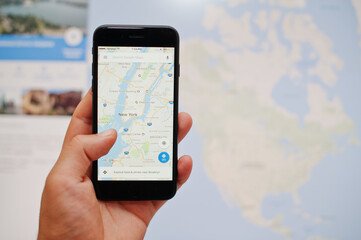Google Maps is a free web mapping application developed by Google Inc. It provides aerial photography, satellite imagery, geographical data, accurate street maps, detailed street plans, real-time traffic information, public transport information, and detailed airport information. Google Maps was one of the first applications to use Google technology in full mobile design. Now it is even more popular in mobile internet use.
I am sure you are wondering what this means for me. As an entrepreneur, I have several routes to take, and one of those is to constantly evolve my business ideas to include multiple ways to carry them to the market. I realize that a great deal of time must be spent conceptualizing ideas, especially if they involve new products or services. I must be able to look at the finished product… in all its glory. That is where Google Maps comes in.
On the other hand, GPS systems are advantageous when driving a car and need to know how to get there quickly. You also need them if you want to shop in town. The problem with GPS and Mobile Phone-based Systems like Android and iPhones is that they only give you the location of your current location. You can also get lost or experience limited battery life… and you really need to be able to see the entire picture to make such a decision. Google Maps, on the other hand, offers an entirely different take on the computer vision issue.

Google Maps West Virginia includes both digital and physical world geometry to create a detailed street view. In addition to viewing the street map, the viewer can zoom in and out using the flip navigation buttons. This ability to zoom in and out gives you the ability to examine large areas of the physical world while still seeing just what is visible to the unaided human eye. Even when you are in a car, driving to your destination, or on foot, you can zoom in and out to examine the entire scene of the physical world. This is an incredible convenience for both the computer vision engineer and the computer vision consumer.
In addition to providing a street view, Google Maps offers a detailed climate overview that includes a humidity analysis, day and time forecast, along with many different visual indicators of precipitation. The user interface for Google Maps has been compared to that of Microsoft Office Suite, which is quite popular with designers. There is no doubt that Google Maps is the superior product to any existing proprietary mapping platform. One of the main reasons is that the developers of the product understand a tremendous amount about the challenges of creating maps in the real world. Therefore, they put tremendous effort into understanding what makes a good map and learning from their mistakes.
The work of the physical world navigation experts has also been incorporated into Google Maps. A few of these experts are Tony Buzan, Ray Holmes, and Hans Flowers. These experts have contributed to Google Maps, making it the most comprehensive mapping solution available today. You can find a full list of all the contributors by clicking on the following link.
Google Maps gives you, the user, several different options for taking a detailed street view of any area. The options include street view imagery that is static or “static map,” which depicts the same view over a set period of time. You can also “show me more,” which allows you to reveal many more detailed street view areas. Another option is the Live Map which animates the street view to show more of the city.
Google Maps also includes an indoor view of the city and a driving simulator mode that enables the user to experience walking on road networks in fully 3D graphics. The Driving Mode’s last option allows the user to experience navigating through various types of traffic scenarios, such as rush hour, expressway, arterial, and city driving. The Street View also allows the user to switch between satellite and aerial views. When combined with the user’s location, these images create a dynamic road network map that the user can interact with and explore.
